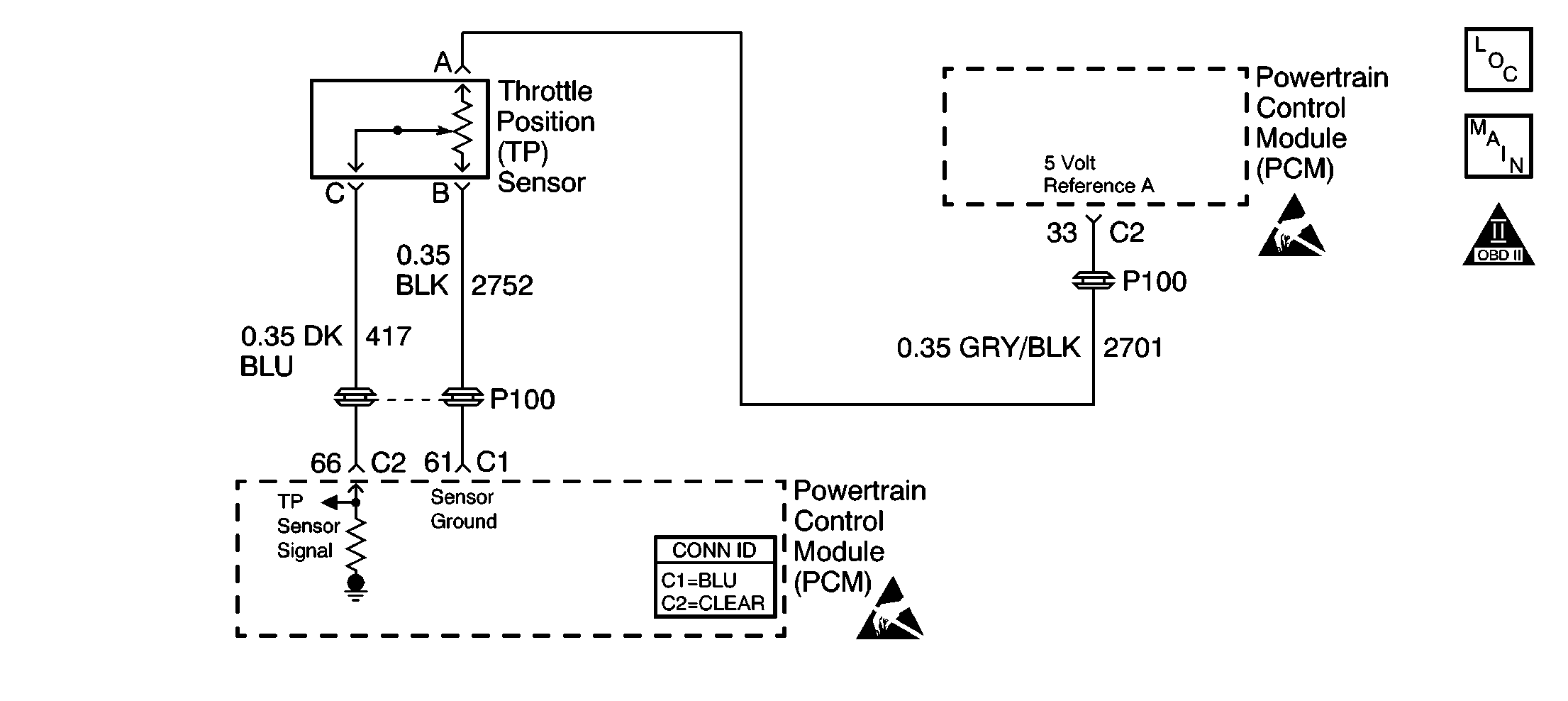
Circuit Description
The throttle position (TP) sensor circuit provides a voltage signal that changes relative to throttle blade angle. The signal voltage will vary from less than 1.0 volt at Closed Throttle to more than 4.0 volts at Wide Open Throttle (WOT). The powertrain control module (PCM) monitors the throttle position and compares the actual throttle position from the TP sensor to a predicted TP value that is calculated from the engine speed. If the PCM detects an excessively low TP sensor signal voltage, DTC P0122 will be set.
Conditions for Running the DTC
The ignition is ON.
Conditions for Setting the DTC
| • | The TP sensor signal voltage is less than 0.16 volt. |
| • | The above conditions are present for longer than 1 second. |
Action Taken When the DTC Sets
| • | The PCM will illuminate the malfunction indicator lamp (MIL) during the second consecutive trip in which the diagnostic test has been run and failed. |
| • | The PCM will store conditions which were present when the DTC set as Freeze Frame/Failure Records data. |
Conditions for Clearing the MIL/DTC
| • | The PCM will turn OFF the malfunction indicator lamp (MIL) during the third consecutive trip in which the diagnostic has run and passed. |
| • | The history DTC will clear after 40 consecutive warm-up cycles have occurred without a malfunction. |
| • | The DTC can be cleared by using a scan tool. |
Diagnostic Aids
Inspect for the following conditions:
| • | Low voltage condition on the TP 5-volt reference circuit caused by high resistance, an open, or a short to ground |
| • | Short to ground on the TP sensor signal circuit |
| • | Open or high resistance on the TP sensor ground circuit |
| • | A malfunctioning TP sensor |
Many situations may lead to an intermittent condition. Perform each inspection or test as directed.
Important: : Remove any debris from the connector surfaces before servicing a component. Inspect the connector gaskets when diagnosing or replacing a component. Ensure that the gaskets are installed correctly. The gaskets prevent contaminate intrusion.
| • | Loose terminal connection |
| - | Use a corresponding mating terminal to test for proper tension. Refer to Testing for Intermittent Conditions and Poor Connections , and to Connector Repairs in Wiring Systems for diagnosis and repair. |
| - | Inspect the harness connectors for backed out terminals, improper mating, broken locks, improperly formed or damaged terminals, and faulty terminal to wire connection. Refer to Testing for Intermittent Conditions and Poor Connections , and to Connector Repairs in Wiring Systems for diagnosis and repair. |
| • | Damaged harness--Inspect the wiring harness for damage. If the harness inspection does not reveal a problem, observe the display on the scan tool while moving connectors and wiring harnesses related to the sensor. A change in the scan tool display may indicate the location of the fault. Refer to Wiring Repairs in Wiring Systems for diagnosis and repair. |
| • | Inspect the powertrain control module (PCM) and the engine grounds for clean and secure connections. Refer to Wiring Repairs in Wiring Systems for diagnosis and repair. |
If the condition is determined to be intermittent, reviewing the Snapshot or Freeze Frame/Failure Records may be useful in determining when the DTC or condition was identified.
Test Description
The numbers below refer to the step numbers on the diagnostic table.
Step | Action | Values | Yes | No |
|---|---|---|---|---|
1 | Did you perform the Powertrain On Board Diagnostic (OBD) System Check? | -- | ||
2 |
Does the scan tool indicate that the TP voltage is less than the specified value? | 0.16V | ||
3 |
Does the DTC reset? | -- | Go to Diagnostic Aids | |
4 |
Does the scan tool indicate TP voltage equal to the specified value? | 5.0V | ||
5 |
Does the DMM indicate reference voltage equal to the specified value? | 5.0V | ||
6 | Test the 5 volt reference circuit of the TP sensor for high resistance or an open. Refer to Wiring Repairs in Wiring Systems. Did you find and correct the condition? | -- | ||
7 | Test all 5 volt reference circuits for a short to ground. Refer to Wiring Repairs in Wiring Systems. Did you find and correct the condition? | -- | ||
8 |
Did you find and correct the condition? | -- | ||
9 | Test the signal circuit of the TP sensor for a short to ground, a high resistance, or an open. Refer to Wiring Repairs in Wiring Systems. Did you find and correct the condition? | -- | ||
10 | Inspect for poor connections at the harness connector of the PCM. Refer to Connector Repairs in Wiring Systems. Did you find and correct the condition? | -- | ||
11 | Inspect for poor connections at the harness connector of the TP sensor. Refer to Connector Repairs in Wiring Systems. Did you find and correct the condition? | -- | ||
12 | Replace the TP sensor. Refer to Throttle Position Sensor Replacement Did you complete the replacement? | -- | -- | |
|
Important: The replacement PCM must be programmed. Replace the PCM. Refer to Powertrain Control Module Replacement/Programming . Did you complete the replacement? | -- | -- | ||
14 |
Does the DTC run and pass? | -- | System OK |
